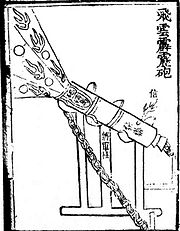| Part of a series on |
| Cannons |
|---|
 |

Gunpowder artillery in the Middle Ages primarily consisted of the introduction of the cannon, large tubular firearms designed to fire a heavy projectile over a long distance. Guns, bombs, rockets and cannons were first invented in China during the Han and Song dynasties and then later spread to Europe and the Middle East during the period.
Although gunpowder was known in Europe during the High Middle Ages due to the usage of guns and explosives by the Mongols and the Chinese firearms experts employed by them as mercenaries during the Mongol conquests of Europe, it was not until the Late Middle Ages that European versions of cannons were widely developed. Their use was also first documented in the Middle East around this time. English cannons first appeared in 1327, and later saw more general use during the Hundred Years' War, when primitive cannons were employed at the Battle of Crécy in 1346. By the end of the 14th century, the use of cannons was also recorded as being used by the Swedes, Poles, Russians, Byzantines and Ottomans.
The earliest medieval cannon, the pot-de-fer, had a bulbous, vase-like shape, and was used more for psychological effect than physical damage. The later culverin was transitional between the handgun and the full cannon, and was used as an anti-personnel weapon. During the 15th century, cannon advanced significantly, so that bombards were effective siege engines. Towards the end of the period, the cannon gradually replaced siege engines—among other forms of aging weaponry—on the battlefield.
The Middle English word Canon was derived from the Tuscan word cannone, meaning large tube, which came from Latin canna, meaning cane or reed.[2] The Latinised word canon has been used for a gun since 1326 in Italy, and since 1418 in English. The word Bombardum, or "bombard", was the earliest term used for "cannon", but from 1430 it came to refer only to the largest weapons.[3]
- ^ Needham, Joseph (1987). Science & Civilisation in China, volume 7: The Gunpowder Epic. Cambridge University Press. p. 266. ISBN 0-521-30358-3.
- ^ "Definition and etymology of "cannon"". Webster's Dictionary. Retrieved 2008-06-02.
- ^ Calvert, James B (2007-07-08). "Cannons and Gunpowder". Mysite.du.edu/~jcalvert/index.htm. Archived from the original on 2007-07-01. Retrieved 2008-06-02.
